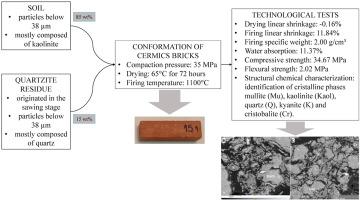Journal of Cleaner Production ( IF 11.1 ) Pub Date : 2020-11-21 , DOI: 10.1016/j.jclepro.2020.125098 M.C.A. Silva , V.A. Leão , E.L. Reis

|
The ornamental stone sector produces a substantial amount of solid waste and effluents that are discarded in a disorderly manner, a fact that has prompted the need for research aimed at reuse. Considering the concepts of sustainable development and conscious mining, this study proposed the incorporation of quartzite residues in the production of ceramics (using soil as raw material) and aimed to reduce production prices, minimize environmental impacts, and obtain a higher quality of ceramic products (with less water absorption and greater resistance). Ceramic bricks were made in accordance with the following variables: replacement percentage (10% and 15%), compaction pressure (28 and 35 MPa), drying temperature (65 °C for 72 h and 110 °C for 24 h), and firing temperature (950 and 1100 °C). Technological tests evaluated the drying and firing linear shrinkage, firing specific weight, water absorption, and resistance to uniaxial compression. After determining the optimal conditions, a flexural tear test and microstructural characterization were also performed. The optimal conditions for making ceramic bricks were a replacement percentage of 15%, compaction pressure of 35 MPa, drying temperature of 65 °C (72 h), and firing temperature of 1100 °C. These results were favorable because of the partial thermal decomposition of the mineral phases with the recrystallization of mullite and cristobalite. The incorporation of the residue resulted in better quality ceramic products, placing them within the limits established for technological applications, whereas none of the compositions made entirely of clay met the technical specifications.
中文翻译:

将石英岩细粉纳入红色陶瓷生产
装饰石材行业产生大量的固体废物和废水,这些废物和废物以无序的方式丢弃,这一事实促使人们需要进行旨在再利用的研究。考虑到可持续发展和有意识采矿的概念,本研究提出将石英岩残留物纳入陶瓷生产中(使用土壤作为原材料),旨在降低生产价格,最小化环境影响并获得更高质量的陶瓷产品(具有较少的吸水率和较大的阻力)。陶瓷砖是根据以下变量制成的:替代率(10%和15%),压实压力(28和35 MPa),干燥温度(65°C持续72 h和110°C持续24 h)以及烧制温度(950和1100°C)。技术测试评估了干燥和焙烧的线性收缩,焙烧的比重,吸水率以及对单轴压缩的抵抗力。确定最佳条件后,还进行了弯曲撕裂试验和微观结构表征。制作陶瓷砖的最佳条件是更换百分比为15%,压实压力为35 MPa,干燥温度为65°C(72 h),烧成温度为1100°C。这些结果是有利的,因为随着莫来石和方石英的重结晶,矿物相部分地热分解。残留物的掺入产生了质量更高的陶瓷产品,使它们处于为技术应用确定的极限之内,而完全由粘土制成的组合物均未达到技术规格。



























 京公网安备 11010802027423号
京公网安备 11010802027423号